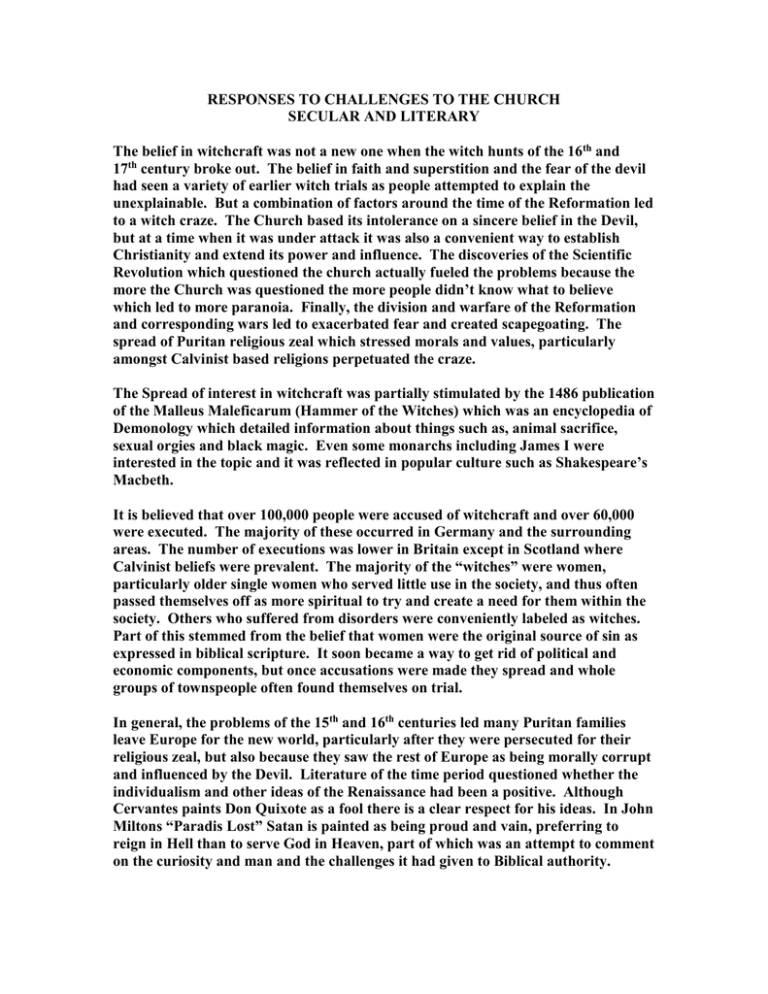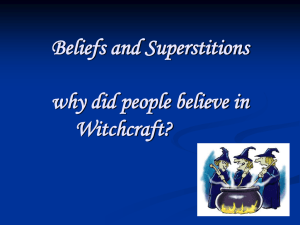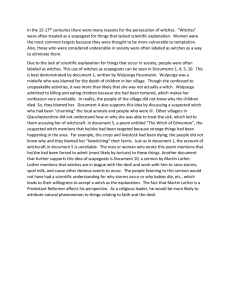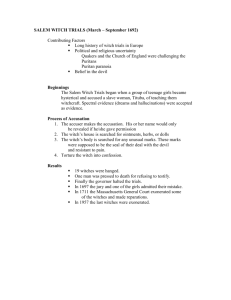RESPONSES TO CHALLENGES TO THE CHURCH SECULAR AND LITERARY
advertisement

RESPONSES TO CHALLENGES TO THE CHURCH SECULAR AND LITERARY The belief in witchcraft was not a new one when the witch hunts of the 16th and 17th century broke out. The belief in faith and superstition and the fear of the devil had seen a variety of earlier witch trials as people attempted to explain the unexplainable. But a combination of factors around the time of the Reformation led to a witch craze. The Church based its intolerance on a sincere belief in the Devil, but at a time when it was under attack it was also a convenient way to establish Christianity and extend its power and influence. The discoveries of the Scientific Revolution which questioned the church actually fueled the problems because the more the Church was questioned the more people didn’t know what to believe which led to more paranoia. Finally, the division and warfare of the Reformation and corresponding wars led to exacerbated fear and created scapegoating. The spread of Puritan religious zeal which stressed morals and values, particularly amongst Calvinist based religions perpetuated the craze. The Spread of interest in witchcraft was partially stimulated by the 1486 publication of the Malleus Maleficarum (Hammer of the Witches) which was an encyclopedia of Demonology which detailed information about things such as, animal sacrifice, sexual orgies and black magic. Even some monarchs including James I were interested in the topic and it was reflected in popular culture such as Shakespeare’s Macbeth. It is believed that over 100,000 people were accused of witchcraft and over 60,000 were executed. The majority of these occurred in Germany and the surrounding areas. The number of executions was lower in Britain except in Scotland where Calvinist beliefs were prevalent. The majority of the “witches” were women, particularly older single women who served little use in the society, and thus often passed themselves off as more spiritual to try and create a need for them within the society. Others who suffered from disorders were conveniently labeled as witches. Part of this stemmed from the belief that women were the original source of sin as expressed in biblical scripture. It soon became a way to get rid of political and economic components, but once accusations were made they spread and whole groups of townspeople often found themselves on trial. In general, the problems of the 15th and 16th centuries led many Puritan families leave Europe for the new world, particularly after they were persecuted for their religious zeal, but also because they saw the rest of Europe as being morally corrupt and influenced by the Devil. Literature of the time period questioned whether the individualism and other ideas of the Renaissance had been a positive. Although Cervantes paints Don Quixote as a fool there is a clear respect for his ideas. In John Miltons “Paradis Lost” Satan is painted as being proud and vain, preferring to reign in Hell than to serve God in Heaven, part of which was an attempt to comment on the curiosity and man and the challenges it had given to Biblical authority. Excerpts from the Malleus Maleficarum, 1486 by Heinrich Kramer and James Sprenger The method of beginning an examination by torture is as follows: First, the jailers prepare the implements of torture, then they strip the prisoner (if it be a woman, she has already been stripped by other women, upright and of good report) [1]. This stripping is lest some means of witchcraft may have been sewed into the clothing--such as often, taught by the Devil, they prepare from the bodies of un-baptized infants, [murdered] that they may forfeit salvation. And when the implements of torture have been prepared, the judge, both in person and through other good men zealous in the faith, tries to persuade the prisoner to confess the truth freely; but, if he will not confess, he bids attendants make the prisoner fast to the strappado or some other implement of torture. The attendants obey forthwith, yet with feigned agitation. Then, at the prayer of some of those present, the prisoner is loosed again and is taken aside and once more persuaded to confess, being led to believe that he will in that case not be put to death. Here it may be asked whether the judge, in the case of a prisoner much defamed, convicted both by witnesses and by proofs, nothing being lacking but his own confession, can properly lead him to hope that his life will be spared--when, even if he confess his crime, he will be punished with death. It must be answered that opinions vary. Some hold that even a witch of very ill repute, against whom the evidence justifies violent suspicion, and who, as a ringleader of the witches, is accounted very dangerous, may be assured her life, and condemned instead to perpetual imprisonment on bread and water, in case she will give sure and convincing testimony against other witches; yet this penalty of perpetual imprisonment must not be announced to her, but only that her life will be spared, and that she will be punished in some other fashion, perhaps by exile. And doubtless such notorious witches, especially those who prepare witch-potions or who by magical methods cure those bewitched, would be peculiarly suited to be thus preserved, in order to aid the bewitched or to accuse other witches, were it not that their accusations cannot be trusted, since the Devil is a liar, unless confirmed by proofs and witnesses. [Page 12] Others hold, as to this point, that for a time the promise made to the witch sentenced to imprisonment is to be kept, but that after a time she should be burned. A third view is, that the judge may safely promise witches to spare their lives, if only he will later excuse himself from pronouncing the sentence and will let another do this in his place. . . . But if, neither by threats nor by promises such as these, the witch can be induced to speak the truth, then the jailers must carry out the sentence, and torture the prisoner according to the accepted methods[,] with more or less of severity as the delinquent's crime may demand. And, while he is being tortured, he must be questioned on the articles of accusation, and this frequently and persistently, beginning with the lighter charges-for he will more readily confess the lighter than the heavier. And, while this is being done, the notary must write down everything in his record of the trial--how the prisoner is tortured, on what points he is questioned, and how he answers. And note that, if he confesses under the torture, he must afterward be conducted to another place, that he may confirm it and certify that it was not due alone to the force of the torture. But, if the prisoner will not confess the truth satisfactorily, other sorts of tortures must be placed before him, with the statement that, unless he will confess the truth, he must endure these also. But, if not even thus he can be brought into terror and to the truth, then the next day or the next but one is to be set for a continuation of the tortures--not a repetition, [2] for they must not be repeated unless new evidences be produced. The judge must then address to the prisoners the following sentence: We, the judge, etc., do assign to you,------, such and such a day for the continuation of the tortures, that from your own mouth the truth may be heard, and that the whole may be recorded by the notary. And during the interval, before the day assigned, the judge, in person or through approved men, must in the manner above described try to persuade the prisoner to confess, promising her [3] (if there is aught to be gained by this promise) that her life shall be spared. The judge shall see to it, moreover, that throughout this interval [Page 13] guards are constantly with the prisoner, so that she may not be left alone; because she will be visited by the Devil and tempted into suicide. Footnotes [1] Sometimes, in place of the prisoner's clothing, a garment furnished by the court was now supplied, to be worn during the torture. [2] This was, of course, a legal fiction, to avoid the merciful restriction put by law upon the repetition of torture. [3] This change in the gender of pronoun is a faithful following of the original. SOURCE: George L. Burr, ed., The Witch Persecutions in translations and reprints from the o0riginal sources of European History, 6 vols. Philadelphia: University of Pennsylvania History Department, 1898-1912) vol. 3, no. 4, pp. 10-13. Found on the “Hanover Historical Texts Project.” <http://history.hanover.edu/texts/mm.html>





